

|
Back to |
| The Front Page |
| News & Features |

|
The McDonnell Tapes
|
|
interview by Mike Orgill Annotations in yellow by Damon Bidencope Signed sidebars by notables of the period photos as credited Author's Foreword, by Mike Orgill Interview with Mike Lufkin McDonnell Posted April 21, 2016
|
It’s been said that “memory is fiction” and when the memories are concentrated on matters in which many ambitious people, sometimes in conflict, invested huge passions, the drama sometimes attains the level of soap opera; facts and opinions become inextricably mixed in the telling, all of it necessarily framed from present time. So we asked some principals in the story to offer alternate points of view, and we include those at appropriate points in the interview. We will also publish a future REVISED EDITION incorporating alternate versions of this oral history based entirely on the recollections of one man.
By Mike Orgill
By the time I entered the "big-time" croquet world the Sonoma-Croquet courts were, unknown to me, under construction. I did live through the first big tournaments in Northern California, the Western Regionals, the Nationals, and the Meadowood Croquet Classic. I remember Tom's court going in, and the construction of the Meadowood courts, the hiring of Neil Spooner and Damon Bidencope, and Neil's eventual firing. In those early days I was very much on the outside looking in, and missed the great controversies surrounding Jack Osborn's sojourn to Northern California during the 1986 USCA Nationals at Sonoma-Cutrer. But there are things I remember clearly that Tom either didn't remember or was vague about.
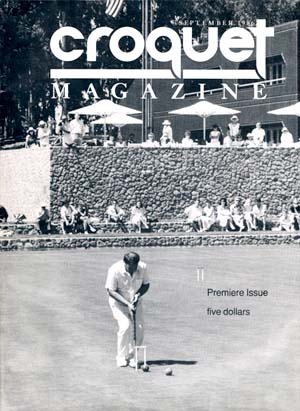
|
| The opening of Sonoma-Cutrer was the big croquet story of 1986, and Mike Orgill wrote the cover article in the premiere issue of CROQUET MAGAZINE to celebrate the event. Neil Spooner is shown in the foreground as the finalist who lost to Stephen Mulliner in the "Sonoma-Cutrer Invitational International." |
I also remember watching a Western Regional being played exclusively at Stern Grove a month or so before we joined the club. The play was contested on two small half courts complete with holes for golf balls.
The Nationals at Sonoma-Cutrer were also played on half courts until at least the quarter finals. I do not remember if there was block play, or whether the old double-elimination system was still in use. (Travel hundreds or thousands of miles to the tournament, lose two or three games, and you were history.)
I am sure that Brice Jones and his wife, Susan Porth, were SFCC club members and played at Stern Grove while taking care of their infant child. Both Brice and Susan were among the better players in the club. I also played against Brice at a Regional in Seattle during that time, losing to him when I went to the wrong wicket during a break.
And I remember the revelation that the Sonoma-Cutrer courts were built and ready for play and the first time I saw them. Brice and Tom had not said a word about them before the great reveal. We called it “Croquet Heaven.” For better or worse my life was changed after that.
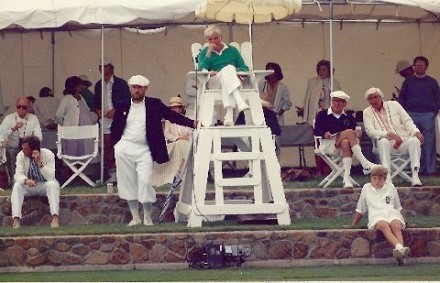
|
| Tom McDonnell surveys the games from the height of the referee chair in an early event. The late Jerry Stark leans against the chair, and Lyle Guernsey on the right (in white) talks to Ned Skinner, owner of the Seattle Seahawks, who hosted two USCA events, in 1983 and 1986. Mike McDonnell photo. |
Fifteen years ago or so, hearing that Tom McDonnell was ill, I decided to cold call him and record his memories of croquet in the San Francisco Bay Area. Tom was the catalyst who enabled me to transition from backyard croquet into the tournament world. I wanted to preserve his memories of our croquet adventures before they faded away.
Bob Alman and I had invaded parks and public spaces all over San Francisco with our backyard equipment in our quest for the perfect croquet grounds, but as soon as we discovered the San Francisco Croquet Club, captained by Tom, we jumped into the USCA croquet world with both feet.
The San Francisco Croquet Club played at an almost comical venue in Stern Grove, a venerable city park. The courts had once been a bowling lawn, and then were used for golf putting. The boundaries sloped along the sides and the surface was studded with golf holes. Disgruntled neighborhood golfers would sometimes appear and launch chip shots at us as we played. Once, a grizzled retiree seized one of our croquet balls and threw it at Bob Alman. It was a dangerous time. On the whole our enthusiastic members prevailed, and croquet at Stern Grove went forward as plans were laid to persuade the City to build two regulation courts in another location in the same park. But we had no inkling of the great Bay Area croquet boom that was to come.
I put Tom's interview tape in a drawer, at first to let it "age", since I did not think it appropriate to publish it at the time. It was too fresh, too close to the events. I thought of the tapes as a historical document, much like the family history narratives one would record with parents or relatives. As the years passed I lost track of the tape and recovered it among my jumbled archives only a few years ago. I transcribed it this year, afraid that it would again be lost in the shuffle. CROQUET WORLD presents it now, somewhat redacted, with comments by some of the people mentioned in the interview.
MIKE ORGILL’s 2002 INTERVIEW
WITH TOM LUFKIN MCDONNELL
Tom Lufkin McDonnell: My memory of you and Bob Alman is so funny that it may be apocryphal though is that one day you walked out of the woods.
Michael Orgill: That's right.
TLM: . . .at the putting green and said hello, we play on a baseball field.
MO: We didn't play on a baseball field, we played at parks around town and at Fort Mason for almost a year and a half. And that was the first time either of us had heard about “real” croquet. And then I remember I read an article about a football strike going on.
TLM: Yes, there was. On the Sporting Green, and I think it was the only time croquet had been on the front page of that.
MO: Yes, and there was an article in the paper about what can you do if you're not watching the Super Bowl...
TLM: And there was a picture of Michael and I in there and I was pointing down for him to take a shot . . .
MO: And that's where I found out about you and the San Francisco club ... we just showed up one day and said we'd like to join and we joined. . . I think that was '82 or something like that . . .
TLM: Yeah, right.
MO: And then I remember that Brice showed up with Susan Porth . . .
TLM: That story is so strange . . . .
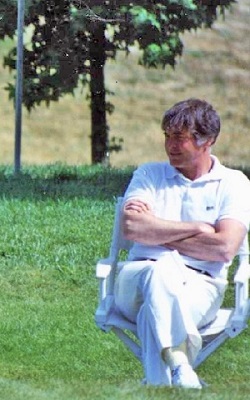
|
| Brice Jones enjoying his own show at Sonoma-Cutrer. Mike Orgill photo. |
MO: Yeah I remember that they were out at Stern Grove in those things [playpens]. . .
TLM: That I do not remember. And we got talking about croquet, and let me think then what happened . . . . All of this is really vague because it's so long ago, but I remember, I guess, I up and built the croquet court. Nothing had been built at Sonoma-Cutrer, we had sort of laughed and discussed it, playing out here in front [of TLM's house], that seemed to be it. And I built that court, now that I think of it I just cannot believe, I built that entirely myself. Period. No help from anybody. Then I got a guy out to lift those railroad ties. I couldn't lift them today. That are around the outside of our croquet court. Anyway, I don't think Brice would remember this, but I said to him, you know, this game is great and I really, and I was digging him at this point and I said you know I am probably going to build a croquet court in those greenhouses. Now I'm still running the business, that was about a wild a thing as you can possibly say, he didn't know whether it was or not, and, within ten days, he believed me, within ten days he was moving with the bulldozers because he wanted to, he wanted to be king of the mountain, as you know, that's always been with Brice, if he's going to get involved he's going to be the person who's gonna be in charge. Then when we eventually got those croquet courts. . . .
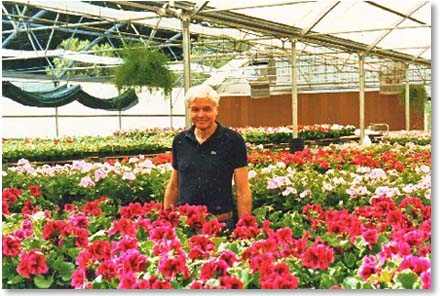
|
| Tom in his greenhouse, circa 1988, that absorbed much of his energies for many years on his Northern California property. He built his own regulation croquet court alongside it. Neil Spooner photo. |
MO: So you mean he just up and built them without any reason to build them?
TLM: Absolutely out of nowhere, just off the top of his head. I often wondered if he built it because he thought that I was going to build a croquet complex. I mean he took a hell of a chance. I mean what's the gain? I doubt that he got any support from anybody over there except that it was his ship and he could do what he wanted. And he proceeded to do it. And then for the first year or two and it may not have been even two years that was called the Wine Country International or something of that kind . . . .
MO: Let me interrupt you for a moment. I remember him playing at Stern Grove . . . when he was playing at Stern Grove had he built the courts?
TLM: Oh, I don't remember him playing at Stern Grove. That's interesting.
MO: Yeah, he played quite extensively there, like when we joined the club.
TLM: Yeah, that's probably what got him going...
MO: And I remember you telling me that you were introducing him to the game or something and actually nothing at that time was said about him building anything and then suddenly we were all told, there's this winery with these courts . . . .
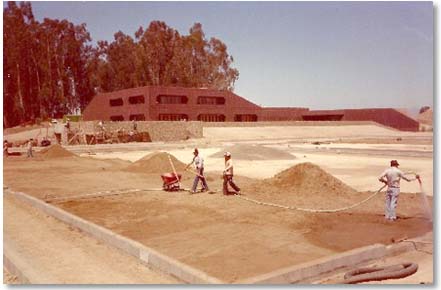
|
| According to McDonnell, Brice Jones chose croquet over polo because it was less messy. These courts were built to become playable in 1985, with beautiful stonework to harmonize with the extraordinarily beautiful winery, vineyards, and rolling countryside. Mike McDonnell photo. |
TLM: That part I can't trace. I will say and it's very funny in the process of trying to find a place to play croquet in San Francisco and why I did I don't know because I was totally disconnected except that I knew Steve Swig from back in Southern California. He had known us and our children and at a time when I had had a terrible automobile accident I came up on crutches with a team from Southern California. I read in the newspaper that they were going to have a money-raiser in San Francisco and they were going to play some croquet and the croquet was going to be played by the 49er's and they would be walking around with these little clubs in their hands and I got the idea that this would be a great way to promote the game, I guess, in the north, because I was still in Southern California at the time. So the next thing I know, I brought up a team, we were all dressed in blue jackets and the whole shooting match on the airplane from Southern California, they were made up of Sam Goldwyn's people and then people who just knew people down there, and when we got off the airplane I was presented with a bouquet of flowers, I can remember this so well, and we put on an exhibition, a croquet thing, and in the process the news had gotten back to the east coast and Jack was screwing around back there, and he uninvited showed up with Billy Harbach and himself I guess it was and Jack tried to make a splash for himself in San Francisco at our expense to put it that way . . . .
MO: What year was this?
TLM: I can't tell you . . . late 70s. . . .
MO: When did you buy the property out there [in Santa Rosa]?
TLM: About 1974.
MO: So, you'd already bought the property . . .but you didn't live there.
TLM: Yes we did.
MO: Then this must have been before 74 then, because you said you still lived in Southern California . . .
TLM: It had nothing to do with the property, no we didn't have property up here at all.
MO: So it was prior to 74.
TLM: That's correct, it would be probably somewhere around 1972, somewhere right in there. And I played one match on crutches and almost killed myself and then I narrated a match between Jack Osborn and somebody else. . . .
MO: Where were you playing?
TLM: Down in Atherton on somebody's estate. It was just a big piece of lawn, it was some kind of event, oh I think it was there to raise money for the opera or something of that kind, and it really was being put together by Steve Swig's ex-wife. That's funny, sometime right in behind that, that year, the fourth of July for example if you can picture this, we had a gravel driveway that went down to the house, it wasn't a big long gravel driveway but I can still see Steve and we had American flags and the kids had flags and Cesare Denova was involved and we all paraded, we had our own parade at 10 o'clock in the morning before we played croquet in the afternoon on the lawn in front of that house. That is a very fabulous kind of piece of property, it is now owned by Stephen Spielberg, but in those days, we were talking about it last night, we bought it for $125,000 [TLM has shifted abruptly to talk about his Santa Rosa residence property] and ten broken windows, it took us eight years bit by bit, I think I spent more time putting that place that piece of property together than I did working for ABC and some of that sort of business. Anyway that's how we sort of got connected with San Francisco based on that article that I saw in the newspaper about Steve's wife. And when we came up here I guess I was determined to get croquet going in San Francisco, and that's when I went to, well let me think about this. I went to the head of the Parks department and the two guys that ran the parks in those days and though this has no reason except they acted rather strangely, and I don't know whatever happened to the two of them but they were like Ike and Mike, and they pretty much ignored me and kept pushing me away. I was getting nowhere when Jack . . .
MO: Jack Brown.
TLM: Jack Brown! And I'll never forget walking into the outer office of the Parks Department and he [Jack Brown] saying we want to see these two guys and the answer was I'm terribly sorry sir you don't have an appointment and he [Jack Brown] said do you know who I am and I'm a lawyer here and he started dropping names and the place looked like it was going to catch on fire. And the door flew open, I can see it today and out came these two guys like it was some kind of a ballet routine, one of them climbing over the other to get to Jack before something terrible happened. And it was agreed then that we would find a place for croquet in San Francisco. I knew about the bowling greens.
MO: The ones in Golden Gate Park. . .
TLM: They knew I knew it but they didn't want me near them. So I went out in the car one day with the head of the parks department, the number two guy, and we drove around and that's how we ended up in Stern Grove, down below on the that putting green. With a little hill on one end. And that's how the croquet began to get going. It was basically Jack Brown, Steve Swig and myself.
MO: Yeah, that's what I understood it to be...
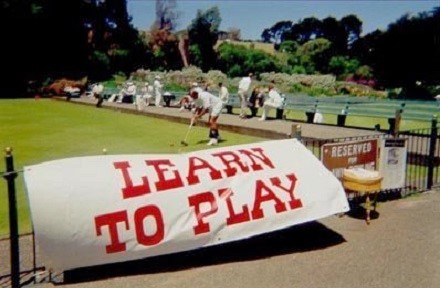
|
| By the mid nineties the San Francisco Open was one of the most popular open American Rules events in the country, maxed out with 64 players on seven lawns and finals on the bowling lawns of Golden Gate Park. The club was celebrated as "the home of champions." The international champions often played in the tournament, scheduled to precede the Sonoma-Cutrer event, without having mastered American Rules--and once in a while they won it. |
TLM: It was like a little family down there, and I didn't know anybody in San Francisco... .As far then as you get into Sonoma Cutrer I had forgotten that Brice [was a member of SFCC], but it's logical that he came down there . . . .
MO: He definitely played there...
TLM: But as you know he never played croquet, period.
MO: Well, I remember he played up in Stern Grove and I remember he played pretty well, and I remember [his wife] Susan Porth was playing pretty well... . Then the courts were put in and he never played once the courts were put in.
TLM: No he didn't. I don't remember that at all, absolutely not.
MO: So, I remember them having a regional there it was like the first tournament...
TLM: Yeah, there was a regional down at San Francisco....
MO: That was the year before I think...
TLM: I mean we were such a bunch of amateurs I remember somebody complaining about the hill at Stern Grove. One corner of that putting green went up a hill and we had a wicket at the top of the hill and if you didn't get it right the ball would go back down the hill again. Somebody from San Francisco said “I'll never come here as long as I live. What kind of shit is this? And I remember feeling “you go out and organize something, you bum.” Brice pushed on to call his thing the Wine Country Open.
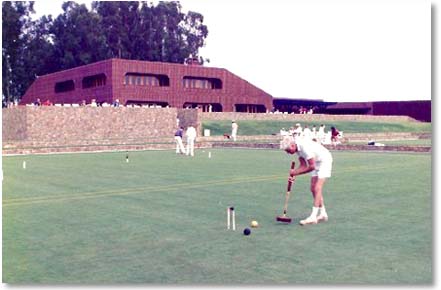
|
| In the foreground, Tom McDonnell competes in the only USCA nationals ever played at Sonoma-Cutrer. Mike McDonnell photo. |
MO: But they had a Nationals there before that.
TLM: I remember that Nationals, and there's an inn here in Santa Rosa that's been here a long. long time on the way out on River Road …
The Western Regionals were held for the first time in 1985 at Sonoma-Cutrer. The meeting discussed took place at the Western Regionals held there. Jack Osborn and Foxy Carter traveled out to observe the tournament prior to agreeing to stage the Nationals there the following year, August 1986. (And Meadowood in the Napa Valley shared the early rounds.) Osborn and Carter were guests of Brice Jones at the regional event. In fact after one very late night reception during the tournament I escorted Foxy and Jack back to the Vintners Inn as they swerved and meandered along the return journey on River Road--a basically straight stretch of road.
MO: Vintner's Inn...
TLM: Yeah, Vintner's Inn. And Jack was here and I remember we had a meeting in the bedroom, and Jack was very uptight and nervous about it because he felt that Brice was trying to take his thunder. Anything that came even close to competing with Jack he didn't like. And I remember that he had sent me boxes of croquet equipment and he wanted me to promote stuff that he was making money on. And it was Jack who made me make up my mind up in Seattle when we eventually got into playing in Seattle, that's of course a whole 'nother story, about starting the newspaper, the newsletter, which ran for awhile. So, there we have the Wine Country Open...
| THE OSBORN INVASION |
|
It came to pass that the USCA Nationals of 1986 were played on the new Brice Jones courts at Sonoma-Cutrer, so Jack Osborn, American emperor of the sport, came out to referee and do business as usual in the virgin Western territories. Groundsperson/greenkeeper Lisa Hagopian, a follower of tennis, had constructed an impressive "referee chair" which elevated an official at least six feet off the ground, rising vertically above the gorgeous horizontal lines of certainly the most beautiful croquet venue ever seen or imagined in America up to that time or since. When Osborn sat enthroned on the chair, he appeared to have taken dominion over Jones' kingdom. That was the last USCA event produced at Sonoma-Cutrer during Jones' reign. - Bob Alman
|
TLM: Yes... .
MO: The Wine Country International....
TLM: The Wine Country International or something like that.
MO: Going back to that, what led him to first do this thing [the World Croquet Championship] out there?
TLM: The International?
MO: Yes, the International.
TLM: Knowing Brice, his ambition to make it the biggest deal around.
MO: So he just came up with that to do that?
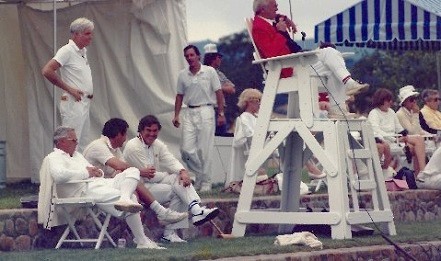
|
| Tom stands on the left, while Ren Kraft sits quietly as Brice Jones laughs with Damon Bidencope and Ed Merrill approaches in the background while a red-coated Jack Osborn enjoys his brief tenure above the Sonoma-Cutrer courts. Mike McDonnell photo. |
TLM: That was right out of his head. The International, the wine thing, was not big enough for him, he recognized that there was croquet around the world, and of course that was in conflict with Jack because Jack was playing only the so-called American game.
Brice had actually gone to New York to meet with Jack and offered to hold the best world-class croquet tournament that could be done. He obviously wanted it held at Sonoma-Cutrer Vineyards for the cross promotional benefit of combining the best of his world-class Chardonnay with the best in the world of croquet. He already had arranged sponsorship with Continental Airlines to bring players to the event.
Jack Osborn in his usual fashion declined the idea largely because it was not his, and secondly he would obviously not have complete control. These events/communications transpired during the 1984–1985 time frame. The WCF was in early formation stages, with the early meeting held at Hurlingham, London in July, 1986, following the conclusion of the MacRobertson Shield and before the (English) Open which was considered the first “World Championship” by this embryonic WCF group, won by Joe Hogan, I believe.
At that same time Jack was also denied entry of a USCA team to the Shield (then included Australia, New Zealand, and Great Britain, the major playing countries) and admonished for his failing to promote (and active efforts to retard in the US) Association Rules croquet. Ashley Heenan (NZ) and Jose San-Tonnelier (Australia) were strongly opposed to Jack’s USCA being allowed to join. With Jack’s unwillingness to be a cooperative participant, Brice saw that while getting the agreement for the one (1986) Nationals to be played at Sonoma Cutrer which would give a little exposure, there was real benefit to be gained from an annual event that claimed world standing.
Continental Airlines was a sponsorship that the Brits (Mulliner) later sabotaged and courted away for the early WCF world titles, but that is another saga, and a reason for Stephen’s non-invitation to Sonoma-Cutrer for many years. This move certainly removed from Brice’s mind any reservation in using the “World” in the title of the subsequent events, which had been respectfully not used at the beginning. The players at the Fountaingrove on the hill in Santa Rosa knew little or none of the back story and events taking place behind the scenes which lead to the announcement.
TLM: Anyway, no one knew that Brice had this on his mind--the World Croquet Championship–-called the Worlds, which to me, I knew a little bit about in England, and what is the famous tournament that comes up every four years?
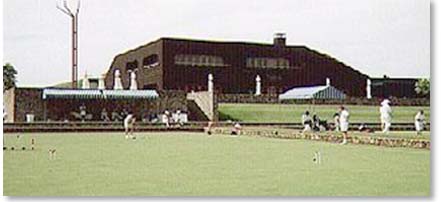
|
MO: The MacRobertson.
TLM: I could tell you a funny story or two about that. Anyway, we were at dinner at Fountaingrove Country Club.... Okay, if you can visualize this, Brice was sitting across from me, I happened to talk to John Taylor about this a couple of days ago, and he remembers it the same way, and the funny part is that the players from England were in one section of the room. . .
MO: This is during the . . . tournament, they're having a dinner?
TLM: Yes, I think it probably was, yes, it must have been the first tournament. Yes, I'll tell you why that sticks in my mind because people were absolutely shocked when Brice kind of pushed himself up with a little insistence and announced to everybody that it wasn't going to be the wine thing anymore, it was going to be the World Croquet Championship and he made no reference to the MacRobertson Shield whatsoever. It was like, “I am now God of Croquet.” Well, I remember there was a rumble over in one corner, that was New Zealand, I thought they were going to get up and kill him. And then the English, they got up and they were mad, and the atmosphere in the place took a dive. And I was stunned. He had never spoken to me about it. He had made up his mind that that was the way it was going to be. And very simply he then proceeded that following year to call it the World Croquet Championship. And off we went. That was 18 years ago.
| GOING INTERNATIONAL |
|
The sole reason Brice changed the title of the event in 1988 was promotional. He believed, correctly, the words "World" and "Championship" would help attract sponsors. It was not an attempt to be "the supreme ruler of croquet." Brice was very aware of international concerns and dealt with them through the correct channels. Brice told me he put the courts in at Tom's suggestion. He said it was going to be either croquet or polo and the fact that croquet players did not shit on their playing surface made the decision easy. - Neil Spooner
|
TLM: We might have had two years of the wine thing [the first version of the Sonoma-Cutrer tournament] ...that's my feeling. I don't think it happened within one year. But it was not more than two.
It was likely at the 1988 tournament as the Brits had stolen/wooed the Continental Airlines sponsorship after getting the contacts in the prior years at the Sonoma Cutrer event.)
MO: How did you get involved in the first couple of tournaments, were you...the tournament director?
| FORMATTING THE CHAMPIONSHIP |
|
I did not endear myself to Brice Jones when at a player's meeting I opposed his idea of naming the tournament the World Championship. I objected to a World title being decided on a single-game format. Also, I was aware that the World Croquet Federation was about to get off the ground and would use a more satisfactory best-of-three match format. I took quite a bit of flak from a number of Americans and for a time even wondered if I'd be asked to leave. I was happy to sneak off the following day to Meadowood, where Tom Lufkin made me feel welcome. He didn't agree with my stand, but he admired me for standing up to Brice. - John Prince, from MY LIFE IN CROQUET, Croquet World Online
|
Tom was integral in the early meetings between Sonoma-Cutrer and Meadowood, who shared the early rounds of the USCA National played for the first time in the west in 1986. Tom was inducted into the Hall of Fame at a dinner that week at Meadowood as part of the event. He was reluctant to embrace the business side of making these large events happen and was concerned that business interests overshadowed the charm and love for the game that he embraced.
MO: Do you remember how Neil came on board there?
| HAPPENSTANCE AND FATE |
|
My first appearance at Sonoma was in 1985 at the USCA Regionals. Brice had met Damon and wanted to put on a demonstration game of Association croquet. Damon asked me to be his opponent, and Brice flew us in. At this time Damon was intending to get a job as the croquet pro. I had no such intentions. However, Lisa Hagopian, Brice's brilliant grounds and greenskeeper, decided I should be approached--hence her trip to Australia in 1986. I was not offered the position until the end of the 1986 tournament. I almost did not attend in 1986, as I had been in Great Britain for six weeks playing in the MacRob. When I told Lisa I would be returning directly home she asked me if I would fly back via California, if they flew my wife over to meet me there. The "trap" was set! After ten days of very well arranged hospitality (aka wild partying) the deal was sealed. - Neil Spooner
|
MO: Because he played in the first one, and he was in the first final.
After a coaching trip to California [Rancho Santa Fe, Birnam Wood in Montecito, Oakland], Brice asked me to return to play an exhibition match at the Western Regional in the summer of 1985. Brice went on to say: “And by the way bring someone else that can really play this game to play against. And so I invited Neil to come to California for the week of the Western Regionals. Neil and I stayed with Drew Juvinall in Santa Rosa.
On a later trip to California around the Arizona Open in early 1986 I mentioned to Brice that someone could generate enough funds to justify employing someone to just promote croquet at Sonoma-Cutrer. We discussed it and he obviously agreed. During that same time period in early 1986 I met Bill Harlan (managing partner/owner of Meadowood Resort) and agreed to promote croquet at Meadowood in the Napa Valley after the 1986 Shield tour in Great Britain. Brice then hired Neil to come to promote the sport at Sonoma-Cutrer. All the Shield participants were invited to the first event and the event was held at a time when they could use the return legs (to NZ and Australia) after the 1986 Open in England. Some others were supplemented and travelled directly out for the event from their resident countries.
TLM: That's interesting. I really don't know how he came aboard. I will always remember, when the time came for him to leave and I don't know if we went to a little restaurant....
MO: Yeah, I remember that...well, he was fired...
| BEYOND DEADNESS |
|
When Neil Spooner came to America in the eighties, the unwritten law of American Rules was "Do not go three-ball dead," but because peeling was a long-established fundament of expert play in Association Rules, he was fearless. So Neil would go dead in attacking opponent to set the lawn for his next turn. One form of this audacity was first seen in the San Francisco Open of 1987, when he debuted "the rout"--by roqueting partner and sending it out of bounds next to the "spent ball" of opponent while croqueting striker ball to position as pioneer. He also debuted the half-Spooner at the 1987 SF Open, against CB Smith, pegging out by a score of 26 -1. For a time, we speculated about a mythic "full Spooner" but he actually achieved it at a later Arizona Open, with a combination of fearless two-ball breaks with partner ball and cannons at two-back, scoring the first known 26-0 in American Rules competition. - Bob Alman
|
MO: Still is.
TLM: Probably so.... Right, and then it [the Sonoma-Cutrer tournament] takes off and goes its own jolly way each year. . . . other things that I remember the Friday night dinners up on the terrace. And I always got up and made a speech. I can remember one of the speeches ending with me saying to the people there something about thank you for the pleasure of your company. And I don't know, and Drew Juvinall was around in those days and I can still see Drew with one of the secretaries up on his shoulders dancing around. It was pretty wild. The tournaments were almost parties. Then the wine thing got started and I don't know when that began--the wine auction.
MO: Well you know I have a video tape of the final game [REUBEN, LINK HERE TO MIKE's VIDEO] and at the end of the game there's the awards presentation, and you're there on the court and Brice is there, and it's a real shock, I should make a copy and send it to you...
TLM: I'd love to see it...
MO: Comparing the scene at the end of last year's to the scene in the first year... it's nothing, a couple of tables, there weren't a hundred people there. There were more like fifty people.
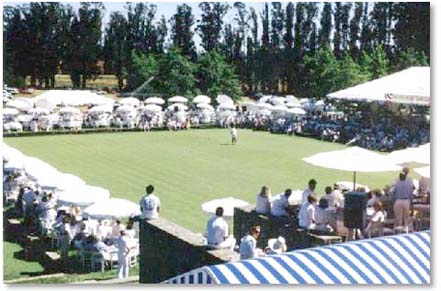
|
| The 1999 Sonoma-Cutrer World Championship. |
TLM: Well, they were the kind of people that came to watch croquet...
MO: Yeah, there were a few people that bought tickets, little tables here and there, but it was nothing.
TLM: I also remember saying to Brice what I wanted to do, I still would have done it if I could have talked him into it but I couldn't, and that was to take the [Sonoma County] sheriff's band, they're all in kilts, they all play bagpipes, and I wanted them to start up in the upper area there, way up where the trees [were], they had a picnic area back up in there, with eucalyptus, and have them come marching down, and hear them swirling in the distance, and then march out on the croquet court leading the croquet players. I think it was a good idea and that's why it didn't happen because only Brice has good ideas, pardon the expression....
MO: Yeah, he sort of kept it closely held, didn't he?
TLM: Very much so, and then I had, oh, we had one, this gives you the psychology of those early years. I'm pressing hard to try to get publicity for this croquet thing, and I'm calling the newspapers and radio stations and all that sort of stuff and I find out indirectly that there's somebody that's calling up and kind of canceling me out. Every time I make a move of some kind there's a call to the source saying, no, no, forget it we don't want anybody, you know, and Brice was afraid that too many people would come and crowd the place. One morning, at seven o'clock in the morning, there's a knock on the door, and here comes Brice, he ends up with his back against the refrigerator I'm at the other end of the table in my pajamas, and we're shouting at each other. I'm saying, “What in the hell are you doing to me?”, and he was blocking the publicity that I was getting for the tournament because he was afraid too many people were going to show. And that's how paranoid, he was very paranoid about it turning into a great big deal. For one reason or another.
Brice was always committed to an event being a “first class event of the highest standard.” The color of the server’s dresses were matched to the color of his chardonnay, etc. . . .
MO: That seems so contradictory...
TLM: Doesn't it, yes. That literally happened. But there was no question, that in the beginning in the first year or two, I don't know, maybe he didn't want the privacy of the winery disturbed, it's almost kinda like that, I don't know why. I don't know what the story was. I can still see the two of us standing here--thank god the table was there. I think I would have grabbed him by the throat. It's not my nature, but I'm half asleep and he's been up for three hours, but I do remember that so well. Then it seemed slowly but surely the wine thing became so big and pretty much I wasn't invited any longer to be there for the Friday night shindig.
Initially Brice wanted the event to hold all the Food and Beverage portions of the event to be staged on the terrace at Sonoma Cutrer, and allow spectator seating on the stone walls around the courts. In August 1987, at the first Domaine Mumm Classic (sponsored by Sam Bronfman and Seagram Classics) held at Meadowood, Brice came to visit early on the finals day.
We had sold over 300 luncheon tickets and were serving a luncheon on the playing surface (covered by green painted plywood) and from a close observation deck wedged into what had been a rock repository until 3 weeks before the event. The event was a week of parties punctuated by days of croquet. It was there that he saw the combination of the luncheon around the court and bringing people down to the courts and how it could work. The wine auction also became part of the mix and theatre of his event later.
MO: And Stan became the tournament director. When did he become the tournament director? He was there for years.
| THE PATMOR DRAW |
|
It was named by the Aussies in the first international Sonoma-Cutrer event, who saw my name on the tournament schedule. Brice Jones had told me he needed a format that could be fairly played on a limited number of courts for up to 32 players over a period of a week, as we had in 1988. The least number of games it would take to win that year was 12, in a format giving each player seven games in the "block" round and at least one more in the "challenge" round, and as many as nine more games by going undefeated in the knockout "challenge" round. At the time, US formats were usually double elimination while other countries--with a greater abundance of regulation courts--typically played round-robins. No one could be asked to fly halfway around the world for just a couple of games, and round robins would have taken too long. This compromise worked pretty well for the entire life of the event--until the WCF world championship was started based on the now-conventional match play instead of single games. - Stan Patmor
|
MO: You were creating that when it was at Sonoma-Cutrer, the first time....
TLM: Yeah, that part of it, and you know, and also, you've got the interesting and crazy business, remember the ACA, and I remember saying to Stanley one year, Stan, you know, and he was complaining about having to do something and I said I'll do it. I'll be the president for a year. And his answer to me was oh no you won't. But the ACA is still around theoretically. And Stan is the president.
MO: What do you remember of Damon [Bidencope] and his activities?
TLM: Oh, I remember him, ohhh... very, very simply he showed up out of nowhere. And he had come over from Australia with his uncle.
MO: When was this, do you think? This was around the late 80s....?
TLM: Yeah. I think he played in a tournament.
MO: Oh, he must have played at Sonoma-Cutrer. He was selected or something.
I was travelling in California and then headed to New York on a vacation with my uncle. I had played croquet with Dave Collins in Beverly Hills and Gunnar Erickson in Malibu, and they gave me Tom’s number and Chris Layton’s number. I was headed to San Francisco and so I called them. (Chris, Steve Swig, and Tom were among the early instigators of the SFCC.)
I had dinner with Chris and Adele Layton and they prompted me to visit Tom and Jane. Tom invited me to his home and showed me his treasured croquet collection (many of the balls still in original boxes) that he had moved north from Pacific Palisades/Los Angeles. He had just finished the court beside his greenhouse and creek.
We played some full moon croquet with Tom and Garth Elliasen (then living nearby in Glen Ellen nearby). Tom mentioned that he wanted to introduce me to Brice and show me the courts that were being built at Sonoma Cutrer. At that time one court was “growing in” and the second was just seeded, under the care of Lisa Hagopian. Brice extended an invitation to come back and provide coaching in the West to help develop interest in the game. The coaching revenues paid for my travel and so it was a nominal expense.
TLM: Yeah, and he was [garbled] around to get himself a job in croquet. I remember specifically having a dinner over at Meadowood with Bill Harlan and Robin Lail and I remember later afterward how he had managed to talk to Bill Harlan and talk him into hiring him. And he also got me to write a letter for him to get him into the country.
Bill Harlan actually came over to Sonoma-Cutrer and introduced himself to me in early February, 1986. He said that it would be foolish to build courts and not have someone to promote the game and make them work. And so he said if I would come and work at Meadowood he would go ahead and build the courts. Brice’s offer was not competitive relative to Harlan’s and the potential of the Meadowood venue.
Tom’s recollection is not clear, as he was very pro the development of the sport in any positive way. When he left Los Angeles after his bad car accident he feared he would never have the joy of playing croquet again in the same way. He was energized by the comradery that surrounded the game. But he subsequently became disenchanted and felt awkward with the juggling of the promotional business interests attached with the game at that time.
Interestingly the Meadowood/Sonoma Cutrer struggle simply helped both venues energize and legitimize the sport in the West, and gain promotion that either party alone could not have accomplished. It’s a shame that Jack Osborn could not have shared this vision.
| FOR LOVE OF THE GAME |
|
I remember those days quite clearly and the twist and turns mentioned in the interview. I think Damon's remarks are right on target concerning Dad’s love of the game and not wanting to get wrapped up in the politics of it all. In hindsight it all seems so crazy--the fighting for control that went on. But many folks thought they were getting in on the ground floor of the next great sport. When that intense but short-lived fever got going, Dad realized that all the hoopla was likely to draw people to the game for possible financial gain, and not for the pure love of croquet. That’s when he exited the stage and just played for fun at home. His court is still short and green just 100 feet from where I’m writing this, and it shall be playable til I take my last breath!! - Mike McDonnell
|
TLM: To get his green card.
MO: When did they put the courts in over there?
TLM: Oh, that's a story. You know, I don't know how I ever came to know Bill Harlan. And I distinctly remember Bill being up here and [my] courts were built at that time.
MO: Were you involved in the building of those?
TLM: Yeah, and Bill and I, he was up at the greenhouses and we talked about the croquet, and I of course was so enthusiastic about it, and he said, I'm going to do that. And he went back to his partner who had not been killed at that point, I can't think of his name, who was killed in the helicopter crash, didn't want croquet there, he wanted the spa there, and the whole idea of the croquet court was just absurd and Bill said to his partner it's going to be there, I want it, and so croquet up here was the catalyst....
Bill’s partners in Meadowood were John Montgomery and Peter Stocker, a keen and good golfer). Peter was tragically killed in a helicopter crash travelling to a large land development deal south of San Francisco in Rancho San Carlos in 1990.
MO: Your court?
TLM: My court.
MO: So it was the catalyst for both of the, over at Sonoma-Cutrer and Meadowood?
TLM: Yes. That's what's so strange and interesting. And it's like the motherlode, and I hope I'm not up here cutting grass at 96. And I'm back playing on the front yard. Maybe it will go the full wheel, I don't know. And Harlan, once he made his mind up that was the end of it. He didn't waste any time.
MO: Do you remember what year that was when that went in?
TLM: Unfortunately, unless I got my papers out I don't know. He was about two or three years behind Brice.
MO: Yeah, I remember they went in after Brice. Like two years after Brice.
Meadowood’s two courts were begun in February 1986 and opened and used for early rounds of the USCA Nationals later that year in August 1986. Brice’s court were playable in late 1984 and early 1985.
TLM: That would be just about right. They were building the lodge at that point so that lodge was kind of tied in to the whole croquet look and they spent a good deal of money when you think about the amount of grading that they did to build those courts.
Meadowood had only 76 rooms at that time and it needed more accommodations to support feasible operations. The practice golf area was sacrificed for the croquet courts and lodge area.
TLM: I'm sure you've heard the story, it was one of the English players and I don't remember his name now, who had come to me at Sonoma-Cutrer and he was enjoying it but he really had a complaint about the croquet courts, and I said what's wrong with them, they're beautiful aren't they? He said, no, they're too good. They were so used to playing in England and I have seen Hurlingham but I saw it in the winter so I really didn't have the chance to compare but a lot of those croquet courts are nothing like the kind of courts we have here and our friend Neil Spooner who had said to me that he liked to come over and play here because it was more like he would play at home. It didn't bother him if there was, if it wasn't super flat and super fast at all. It was a challenge in itself.
MO: I think they upgraded their courts after coming over here, that's what I've been hearing....
TLM: Yes, maybe they did to some extent, but I have the feeling that they don't have the money over there, and its all like public facilities. Hurlingham is very handsome, that's all, the river Thames runs by there, and you'll pardon the expression, club house, which is not the word for it, it's like a southern mansion, and the polo fields off in the distance, it's very beautiful and then you see a major tournament going on and it looks like there are ten people watching it. That takes me to a very quick aside when we talk about the MacRobertson Shield, I was playing croquet one day at Sam Goldwyn's and unbeknownst to any of this a fellow drove up and got out and he had a boater, a straw hat on, and he had a beautiful mohogany case like a gun case, and he came up and introduced himself, and he was one of the players in the MacRobertson Shield, I think in fact he later on committed suicide.
MO: Was that Keith Wiley?
TLM: Oh, no, no. Keith was the one who came to me complaining about the courts.
MO: Now that you talk about this the name is on the tip of my tongue. Was he a very strange character?
TLM: Oh, yes. That's the early MacRobertson Shield back in the late '70s,
MO: Paul Hand?
TLM: No. And he was tall and thin, I remember seeing a picture of him in their publication. And he was extremely polite and he opened up this case and it was lined in velvet and here is this croquet mallet he gets it out and he came over and we played a little croquet and after about an hour he said he had to go. And he never showed up again. I mean he just totally disappeared. He was in a state of shock. Here we have a situation where the grass was not close like a putting green, where we played the balls shot over the edges of the steps, that was the way you could hit high, and of course we had the sand trap which had been built to slow Louie Jourdan down which didn't work. We would always laugh about it. Louie would light a cigarette at the beginning of a game. And he could usually make it all the way around before he was finished with the cigarette. It's all amazing....including going up to Seattle and getting croquet going up there. Did you ever play in any of those tournaments?
MO: Yes, I played in Seattle....
| THE BREAKS IN SEATTLE |
|
The USCA Western Regional of 1983 was played on the practice fields of Ned Skinner's Seattle Seahawks football team. It was actually the first regional Mike Orgill and I played in together. Tom had watched us leaving easy break-making targets for opponents in game on the SFCC courts and warned us, "You can't get away with that kind of play in Seattle." He was right. Melanie Marsac and I were the only spectators I recall viewing the singles final, with Stan Patmor and Gerry Bassford playing well into the cocktail hour, with a bottle of Scotch rotating around the peg for each of them taste from time to time. Patmor won singles and with Bassford took doubles--as Arizona players were expected to do in those days. Brice Jones and his wife Susan Porth won the B flight doubles. By the next year Mike and I had learned to play breaks and defend against them and brought back trophies from the 1984 Western Regionals in Beverly Hills. - Bob Alman
|
MO: That was before my time, I think.....
TLM: Funny time, and you know, playing out on the island outside of Seattle, and having Harvard there, and Janie was saying that the croquet club up there has gotten down to only about fifteen players, a lot of them were older and they, you know, Harvard Palmer is still alive, but a number of them have died and I don't know how it's doing. Barbara Mitchell, she's the person who is down in Palm Springs for this tournament, Janie says she's very nice . . . . So, other than that one of the other memories I have of that court but that was when we played, it wasn't the Nationals, could have been the Regionals, no, it was the Nationals, and my partner was my friend in Arizona who is a jet pilot who is always invited back to Sonoma-Cutrer every year.....
MO: Ren Kraft.
TLM: Ren Kraft. And, uh, Ren and I ended up, we were in the semi-finals, and lost a match because I missed a three-foot shot, you know, you remember these things and it's like, oohh!
Ren Kraft, as a pilot, was always invited to play because Brice was an air force combat pilot in Vietnam, prior to earning his Harvard MBA, and so the die was cast for Ren to be a perpetual invitee. Brice’s Air Force days were also the reason why Sonoma-Cutrer used blue landing lights at night on its approach drive to the winery despite being only a few miles from a local airport. (What could possibly go wrong here?)
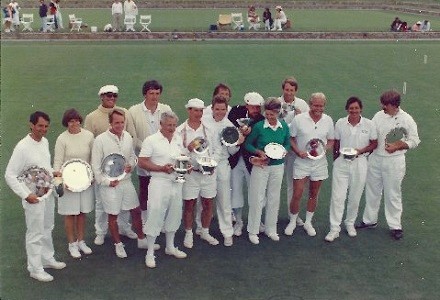
|
| Ren Kraft captured the big trophy in the 1986 USCA Regional, while others also took home mementos. Some guesses are included in this caption info: left to right, it's Barry and Jacqui Fitzpatrick from Rancho Santa Fe; three places over, Ren; then Garth Eliassen, Mike McDonnell, and Jane McDonnell (in green sweater) Dave Collins from Beverly Hills, Dan Lindlom from Puget Sound, Ed Merrill, and Dave Dondero. This photo, supplied by Mike McDonnell, may have been taken by the elder McDonnell from his referee chair. |
TLM: Now that I don't ever remember.
MO: Yeah, they were all half courts. I don't know whether they put them to full courts for the final.
TLM: Isn't that funny.
MO: All of the tournament was on half courts and the Regional too was half courts. In fact the Sonoma-Cutrer club played on half courts for a long time.
USCA rules events were played on half courts, but major Association Rules tournaments were never played on half courts!
TLM: And we did up here at our place because it made it easier for people to.... I wouldn't do it today...but in those days I thought it was a better way to get people started in croquet.
[Very short gap in tape. Discussion has turned to the size of the Sonoma-Cutrer courts.]
TLM: ... to extend the length to about another quarter length and Brice could have gotten four courts out of Sonoma-Cutrer.
MO: Well... after we paced it off we measured it as precisely as we could with tape measures that we had and we determined that all he had to do was, you know, the east/west direction, the narrow direction on both courts, if you pushed the wall back seven feet....
TLM: . . . at the end of the court....
MO: ...at the end of the court, you could have two full-size courts on both sides....
TLM: I remember that discussion coming up and I know that Brice was privy to that, but by that time those walls had been put up there, and the massive amount of work that went into those walls . . . .
MO: But it would have been so simple....
TLM: As simple as can be.
MO: In fact now, I think we determined that we, if you put two full courts on each side, you know, and the way it's mowed they have the higher grass mowed in a boundary around the courts . . .
The Sonoma-Cutrer courts were built with the length to accommodate tennis as a fall-back possibility/option.
TLM: Yes. Sure.
MO: If you mowed that flat, it's the same kind of grass, if you mowed that flat all the way around and you put it out as far as you could you could have 90% full-size courts.
TLM: I'm really not surprised at all to hear that. But that was, again, you know, you mention something like that to Brice, he would put his head under his arm like he was a turtle. He was going to do it his way, period. The fact that they ripped those courts out two years ago . . . .
MTO: Yeah, two...three years ago...[around 1999].
TLM: Because they were unhappy with seeing that moss growing.
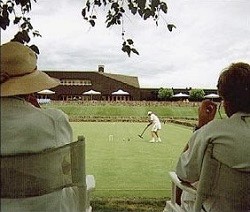
|
[TAPE ENDS]
|
WHERE ARE THEY NOW?
Mike McDonnell succeeded the late Jerry Stark as croquet pro at Meadowood, lives in the house Tom and Jane restored, and still maintains the full-size croquet lawn Tom built next to his greenhouse. Damon Bidencope currently has a real estate appraisal and consulting company in the Carolinas with a primary focus on the valuation of real property assets for financial investment decisions and expert witness testimony in the south eastern United States. Stan Patmor still lives in Phoenix. Bob Alman, editor of Croquet World Online, moved East to organize and manage the National Croquet Center in 2000 and still lives in West Palm Beach and volunteers at the Center. After selling Sonoma-Cutrer, Brice Jones founded Emeritus Winery in Sebastopol, California. Neil Spooner left California in 1994 and is now retired and living on a small island in the South Pacific called Awestralia. Mike Orgill was for 25 years the president of the Sonoma-Cutrer Croquet Club, has held many USCA offices, is the American representative on the World Croquet Federation Management Committee, and still lives in Rohnert Park, California and plays croquet at Sonoma-Cutrer. |
Anyone mentioned or referred to in the interview above is invited to send comment to the editor which may or may not be included as a sidebar in a future REVISED EDITION. Oral histories are always necessarily one-sided and framed by the speaker’s personal viewpoint at the time. Our intention is to arrive finally at a semblance of “the truth” by balancing the main narrative with alternate points of view. Email your comments to BobAlman@aol.com.